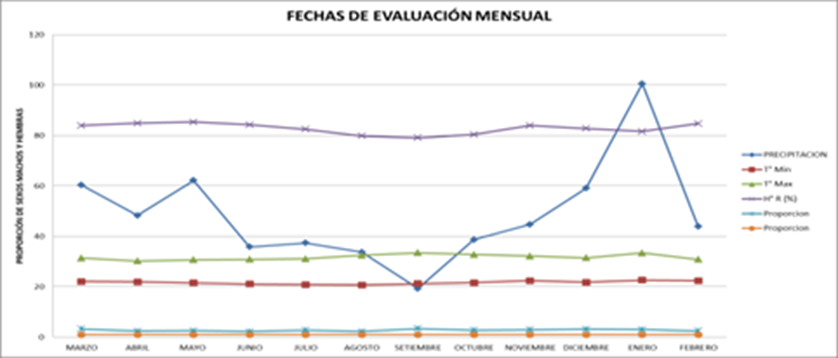Fluctuación poblacional de adultos de Sagalassa valida Walker (Lepidoptera: Brachodidae) en Stachytarpheta cayennensis (Rich.) Vahl
DOI:
https://doi.org/10.55996/dekamuagropec.v5i2.270Keywords:
Borer, flowering, proportion, sowingAbstract
Adults of Sagalassa valida Walker (Lepidoptera: Brachodidae) are attracted to the nectars of weed flowers, including Starchytarpheta cayennensis. However, when they are larvae, they damage the roots and consume them completely. The objectives of this work were to determine the population fluctuation of adults of Sagalassa valida, the relationship and sex ratio. The research was carried out in the province of Tocache from January 2015 to February 2016, in three oil palm plots in which verbena was planted. Verbena was planted on two dates: the first in January and the second in May, the purpose of which was to flower throughout the year. Once in flower, adults were captured using an entomological net, making 2 passes through each verbena plant, from 7:00 to 8:30. and from 4:30 p.m. to 6:00 p.m., the adults captured daily were recorded. The results indicate that the population increases during May, with its highest peak in August to September due to low rainfall and variations in temperature and humidity, decreasing from October to a lower level in February, due to increased rainfall.
Downloads
References
Alvarado Aguilar, A., & Ballarte Beraún, N. G. (2020). Factores determinantes de las exportaciones de aceite de palma: tecnología, capacitación y calidad de la Región Ucayali durante el periodo 2013-2018. Universidad Peruana de Ciencias Aplicadas.
Calvache, H. H., Salamanca, J. C., Aldana de la Torre, R. C., Chávez, C. A., & Coral, J. (2004). Reconocimiento de insectos depredadores del barrenador de raíces Sagalassa valida Walker en la palma de aceite. Revista Palmas, 25(especial,), 232–239. http://publicaciones.fedepalma.org/index.php/palmas/article/view/1087
Charry, A., Vélez, A., Romero, M., Ivanova, Y., Tristán, M., Lema, S., Sánchez, J., Orjuela, F., & Jäger, M. (2020). Estrategia integral para el fortalecimiento del plan de competitividad de la cadena de palma aceitera en Ucayali. Alianza de Bioversity International y El Centro Internacional de Agricultura Tropical (CIAT). https://hdl.handle.net/10568/108442
Cruz-Pérez, A., Sánchez-Soto, S., Ortiz-García, C., & Pérez-De La Cruz, M. (2009). DIVERSIDAD Y DISTRIBUCIÓN DE ARAÑAS TEJEDORAS DIURNAS (ARACHNIDA: ARANEAE) EN LOS MICROHÁBITATS DEL AGROECOSISTEMA CACAO EN TABASCO, MÉXICO Aracely De La Cruz-Pérez, Saúl Sánchez-Soto, Carlos Fredy Ortiz-García, Manuel Pérez-De La Cruz,. Boletín Del Museo de Entomología de La Universidad Del Valle, 10(2), 1–9.
De Los Ríos Dantas, A. R. (2022). Análisis multitemporal por pérdida de cobertura boscosa 2005 - 2020 por palma aceitera para minimizar la deforestación Ucayali. http://repositorio.ucv.edu.pe/bitstream/handle/20.500.12692/47102/Gutierrez_RS-SD.pdf?sequence=1&isAllowed=y
Egonyu, J. P., Baguma, J., Martínez, L. C., Priwiratama, H., Subramanian, S., Tanga, C. M., Anankware, J. P., Roos, N., & Niassy, S. (2022). Global Advances on Insect Pest Management Research in Oil Palm. Sustainability, 14(23), 16288. https://doi.org/10.3390/su142316288
Fitzherbert, E., Struebig, M., Morel, A., Danielsen, F., Bruhl, C., Donald, P., & Phalan, B. (2008). How will oil palm expansion affect biodiversity? Trends in Ecology & Evolution, 23(10), 538–545. https://doi.org/10.1016/j.tree.2008.06.012
García-García, M. Á., Ibarra-Nuñez, G., Martínez-Martínez, L., & Chamé-Vázquez, D. (2024). Gremios de arañas ( Arachnida : Araneae ) en cafetales con diferente intensidad de manejo en Oaxaca , México MARTÍNEZ-. Revista de La Sociedad Entomológica Argentina, 7471(2), 17–29.
Junquera, M. J. (2020). Expansion of Industrial crops in Southeast Asia: The case of the oil palm in Indonesia and Malaysia. Huellas, 24(1), 53–73. https://doi.org/10.19137/huellas-2020-2404
Kamil, N. N., Xiao, S., Syed Salleh, S. N., Xu, H., & Zhuang, C. C. (2024). Nonlinear impacts of climate anomalies on oil palm productivity. Heliyon, 10(15), e35798. https://doi.org/10.1016/j.heliyon.2024.e35798
León Carrasco, J. C. (2023). La palma aceitera es el cultivo líder en el desarrollo de la Amazonía peruana. Agraria, 1–4. https://agraria.pe/noticias/la-palma-aceitera-es-el-cultivo-lider-en-el-desarrollo-de-la-31421
Löhr, B., & Narváez, A. (2021). Land use and terrestrial arthropods at the Colombian Pacific coast. Revista Colombiana de Entomología, 47(1), 1–8. https://doi.org/10.25100/socolen.v47i1.7640
Mendoza, C., Cañarte, E., Celi Soto, A., Cedeño-García, G., & Fernández, L. (2024). Estrategias de diagnóstico y manejo del barrenador de raíces (Sagalassa válida “Walker”) en híbridos OxG de palma aceitera. Revista Alfa, 8(23), 622–631. https://doi.org/10.33996/revistaalfa.v8i23.290
Morales Rodríguez, A., Barrios Trilleraa, C. E., Montes Bazurto, L. G., Aldana de la Torre, R. C., Beltrán Aldana, I. J., Contreras Arias, L. J., Pastrana Sánchez, J. L., Rosero Guerrero, M., & Castillo Villaraga, N. J. (2023). Insectos asociados a los cultivares híbridos interespecíficos OxG [Corporación Centro de Investigación en Palma de Aceite, Cenipalma.]. In Los híbridos interespecíficos OxG de palma de aceite. https://doi.org/10.56866/9789588360959.13
Sánchez Valencia, R. M. (2014). Colecta e identificación de las principales plagas que atacan a la palma africana Elaeis guineensis Jacq, y sus reguladores naturales. In Universidad Nacional De Loja. http://dspace.unl.edu.ec/jspui/bitstream/123456789/17025/1/TESIS WILSON FERNANDO.pdf
Sarmiento, A., Benítez, E., & Aldana de la Torre, R. C. (2005). Descripción de la capacidad depredadora de las hormigas Pachycondyla harpax y Pachycondyla obscuricornis, sobre Sagalassa valida Walker, barrenador de raíces en la palma de aceite. Revista Palmas, 26(2), 23–38. http://publicaciones.fedepalma.org/index.php/palmas/article/view/1130
Sendoya Corrales, C. A., Matabanchoy Solarte, J. A., Pastrana Sánchez, J. L., & Bustillo Pardey, Á. E. (2000). Comportamiento poblacional del adulto de Sagalassa valida Walker ( Lepidoptera : Glyphipterigidae ), en plantaciones de palma de aceite. Sostenibilidad y Eficiencia Para La Palmicultura Colombiana.
Suárez-Forero, D. A., Correa-Ramírez, M. M., & Álvarez-Zagoya, R. (2011). Gremios Ecológicos de Arañas (Arachnida: Araneae) Asociados a Cultivos y su Vegetación de Borde en el Estado de Durango y Zacatecas, México [Vidsupra Vol.3 No.37-44]. In Vidsupra (Vol. 3). https://repositorioslatinoamericanos.uchile.cl/handle/2250/2881269
Tang, K. H. D., & Al Qahtani, H. M. S. (2020). Sustainability of oil palm plantations in Malaysia. Environment, Development and Sustainability, 22(6), 4999–5023. https://doi.org/10.1007/s10668-019-00458-6
Vasquez Quinticuari, P. K. (2020). Restablecimiento de la sucesión ecológica secundaria en un biotopo de shapumba (Pteridium aquilinum (L.) Kuhn) en el caserío San Juan, región San Martín. In Facultad De Zootecnia. http://repositorio.unas.edu.pe/bitstream/handle/UNAS/1625/TS_HRP_2019.pdf?sequence=1&isAllowed=y
Zakaria, M. R., Ahmad Farid, M. A., Hafid, H. S., Andou, Y., & Hassan, M. A. (2024). Practical role of oil palm fronds in Malaysia’s sustainable palm oil industry. Industrial Crops and Products, 222, 119753. https://doi.org/10.1016/j.indcrop.2024.119753

Downloads
Published
How to Cite
Issue
Section
License
Copyright (c) 2024 Oliviño Zegarra-Arteaga

This work is licensed under a Creative Commons Attribution 4.0 International License.
Los autores que publican en esta revista aceptan los siguientes términos:
- Los autores conservan los derechos de autor y conceden a la revista el derecho publicación con la obra, simultáneamente licenciada bajo una licencia de Creative Commons CC By que permite a otros compartir el trabajo, pero citando la publicación inicial en esta revista.
- Los autores pueden celebrar acuerdos contractuales adicionales separados para la distribución no exclusiva de la versión publicada de la obra de la revista (por ejemplo, publicarla en un repositorio institucional o publicarla en un libro), pero citando la publicación inicial en esta revista.
- Se permite y anima a los autores a publicar su trabajo en línea (por ejemplo, en repositorios institucionales o en su sitio web) antes y durante el proceso de presentación, ya que puede conducir a intercambios productivos, así como una mayor citación del trabajo publicado (https://web-archive.southampton.ac.uk/opcit.eprints.org/oacitation-biblio.html)














